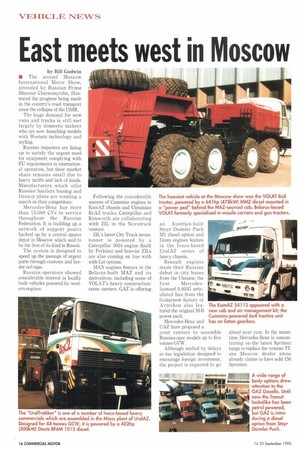East meets west in Moscow
Page 18

If you've noticed an error in this article please click here to report it so we can fix it.
by Bill Godwin • The second Moscow International Motor Show, attended by Russian Prime Minister Chernomyrdin, illustrated the progress being made in the country's road transport since the collapse of the USSR.
The huge demand for new vans and trucks is still met largely by domestic makers who are now launching models with Western technology and styling.
Russian importers are lining up to satisfy the urgent need for equipment complying with EU requirements in international operation, but their market share remains small due to heavy tariffs and lack of funds. Manufacturers which offer Russian hauliers leasing and finance plans are stealing a march on their competitors.
Mercedes-Benz has more than 15,000 CVs in service throughout the Russian Federation. It is building up a network of support points backed up by a central spares depot in Moscow which said to be the first of its kind in Russia.
The system is designed to speed up the passage of urgent parts through customs and border red tape.
Russian operators showed considerable interest in locally built vehicles powered by western engines. Following the considerable success of Cummins engines in KamAZ chassis and Ukrainian KrAZ trucks, Caterpillar and Kenworth are collaborating with ZIL in the Novotruck venture.
ZIL's latest City Truck seventonner is powered by a Caterpillar 3054 engine (built by Perkins) and heavier ZILs are also coming on line with with at options.
MAN engines feature in the Belarus-built MAZ and its derivatives, including some of VOLAT's heavy construction/ crane carriers. GAZ is offering an Austrian-built Steyr Daimler Puch M1 diesel option and Deutz engines feature in the Iveco-based UralAZ series of heavy chassis.
Renault engines made their Russian debut in city buses from the Ukraine; the
first Mercedeslicensed 0.405G articulated bus from the Golizynow factory of Avtrokon also featured the original M-B power pack.
Mercedes-Benz and UAZ have proposed a joint venture to assemble Russian-spec models up to five tonnes GVW.
Although stalled by delays in tax legislation designed to encourage foreign investment, the project is expected to go ahead next year. In the meantime Mercedes-Benz is concentrating on the latest Sprinter range to replace the veteran Ti: one Moscow dealer alone already claims to have sold 150 Sprinters.
















































































































